Evaluating the Capability of Satellite Hyperspectral Imager, the ZY1–02D, for Topsoil Nitrogen Content Estimation and Mapping of Farmlands in Black Soil Area, China
Abstract
:1. Introduction
2. Materials and Methods
2.1. Study Area
2.2. Data Sets
2.2.1. Sampling and Geochemical Measurement
2.2.2. Spectral Measurement
2.2.3. ZY1-02D Hyperspectral Image
2.2.4. GlobeLand30 Dataset
2.3. Data Pre-Processing
2.3.1. Laboratory Spectra Pre-Processing
2.3.2. Hyperspectral Image Pre-Processing
2.4. Methodology
2.4.1. Sensitive Spectral Algorithm
2.4.2. Partial Least Squares Calibration and Validation
2.4.3. Soil Nitrogen Content Mapping
3. Results
3.1. Sensitive Spectral Bands for Soil N Content Estimation
3.2. PLSR Calibration and Validation for Soil N Content Estimation
3.3. Soil N Contents Estimaiton and Mapping
4. Discussions
5. Conclusions
Author Contributions
Funding
Institutional Review Board Statement
Informed Consent Statement
Data Availability Statement
Acknowledgments
Conflicts of Interest
Appendix A
| Year | Attribute | Data | Method a | Modelling Bands(nm) | Cal/Val b | R2 | Author |
|---|---|---|---|---|---|---|---|
| 1986 | N (total); % | Lab | MLR | 1702, 1870, 2052 | 72/48 | 0.92 | Dalal et al., |
| 1999 | N (total); mg/kg | Lab | PLSR | 1100–2498 | 120/59 | 0.95 | Reeves et al., |
| 2001 | N (total); g/kg | Lab | PCR | 400–2498 | 30/119 | 0.85 | Chang et al., |
| 2002 | N (total); g/kg | Lab | PLSR | 400–2498 | 76/32 | 0.86 | Chang et al., |
| 2003 | N (total); g/kg | Lab | PLSR | 400–2500 | 144/cross | 0.62 | Thomas et al., |
| 2004 | N (total); g/kg | Lab | PLSR | 400–2500 | 174/cross | 0.95 | Moron et al., |
| 2007 | N (total); mg/g | Lab | PLSR | 350–2500 | 103/cross | 0.87 | Mutuo et al., |
| 2011 | N (total); g/kg | Lab | PLSR | 1250–2500 | 217/78 | 0.95 | Xie et al., |
| 2013 | N (total); g/kg | Lab | SMLR | 1400, 2250 | 96/cross | 0.48 | Shi et al., |
| 2013 | N (total); g/kg | Lab | PLSR | 1450, 1850, 2250, 2330, 2430 | 96/cross | 0.56 | Shi et al., |
| 2013 | N (total); g/kg | Lab | SVM | 350–2500 | 96/cross | 0.58 | Shi et al., |
| 2017 | N (total); g/kg | Lab | PLSR | 900–1700 | 118/58 | 0.79 | Xiao et al., |
| 2019 | N (total); % | Lab | PLSR | 900–1700 | 100/50 | 0.92 | Li et al., |
| 2019 | N (total); % | Lab | PLSR | UVE c | 100/50 | 0.93 | Li et al., |
| 2019 | N (total); % | Lab | PLSR | SPA c | 100/50 | 0.92 | Li et al., |
| 2014 | Stable N; mg /g | Hyperion | PLSR | 530–590; 700–790; 1500–1590; 2200–2330 | 18/NaN | 0.69 | Anne et al., |
| 2015 | N (total); g/kg | Hyperion | PLSR | 155 bands | 78/30 | 0.63 | Gopal et al., |
| 2018 | STN; g/kg | Landsat 5 TM | SMLR | RGB + NDVI | 92/23 | 0.49 | Wang et al., |
| 2019 | N (total); g/kg | Sentinel-2A | RF | 13 bands | 104/cross | 0.32 | Zhang et al., |
| 2019 | N (total); g/kg | Sentinel-2A | RF | 12 Indices | 104/cross | 0.46 | Zhang et al., |
| 2019 | N (total); g/kg | Landsat 8 OLI | BRT/RF/SVM | RGB + NDVI | 85/cross | 0.37 | Zhou et al., |
| 2019 | N (total); g/kg | Sentinel-1A | BRT/RF/SVM | Backscatter coefficients | 85/cross | 0.44 | Zhou et al., |
| 2020 | N (total); kg m−2 | Landsat 8 OLI | GWR/MLSR/BRT | 12 Indices | 410/103 | 0.51 | Wang et al., |
| 2020 | STN; g/kg | Sentinel-1A + Sentinel-1B + Sentinel-2A | BRT/RF/SVM | Backscatter coefficients + RGB + 3 indices | 179/cross | 0.21 | Zhou et al., |
| 2021 | N (total); % | Airborne(CASI-SASI) | PLSR | 380–2450 | 22/cross | 0.44 | Vilém et al., |
| Data Sets | Sample Size | Nitrogen Content (μg/g) | SD | VC | |||||
|---|---|---|---|---|---|---|---|---|---|
| Min | Q1 | Median | Q3 | Max | Mean | ||||
| Dt1 | 50 | 1329 | 2070 | 2366 | 2800 | 4206 | 2500.40 | 696.15 | 0.278 |
| Dt2 | 50 | 1433 | 2034 | 2398 | 2813 | 3930 | 2511.58 | 565.06 | 0.225 |
| Dt3 | 50 | 1292 | 1991 | 2329 | 2657 | 3414 | 2333.00 | 500.78 | 0.215 |
| Dt4 | 50 | 1372 | 2001 | 2203 | 2462 | 3013 | 2234.16 | 380.33 | 0.170 |
| Dt5 | 50 | 1256 | 1674 | 2138 | 2365 | 2801 | 2084.64 | 435.82 | 0.209 |
| Ds1 | 50 | 1224 | 1950 | 2335.5 | 2950 | 4695 | 2550.80 | 817.56 | 0.321 |
| Ds2 | 100 | 1224 | 1982 | 2343.5 | 3073 | 4798 | 2568.92 | 823.38 | 0.321 |
| Ds3 | 200 | 1224 | 1991 | 2354 | 3076 | 5031 | 2579.28 | 829.08 | 0.321 |
| Ds4 | 400 | 1224 | 2352 | 2356 | 2356 | 5227 | 2583.28 | 832.13 | 0.322 |
| Ds5 | 600 | 1224 | 1996 | 2356 | 3089 | 5269 | 2586.63 | 834.26 | 0.323 |
| De | 46 | 781 | 1171 | 1365 | 1536 | 2334 | 1393 | 335.75 | 0.24 |
References
- Liu, X.; Burras, C.L.; Kravchenko, Y.S.; Duran, A.; Huffman, T.; Morras, H.; Studdert, G.; Zhang, X.; Cruse, R.M.; Yuan, X. Overview of mollisols in the world: Distribution, land use and management. Can. J. Agric. Sci. 2012, 92, 383–402. [Google Scholar] [CrossRef]
- Zhang, Z.; Sui, Y. A Brief Introduction to Chinese Mollisols, New Advances in Research and Management of World Mollisols, Harbin, China; Liu, X.B., Song, C.Y., Cruse, R.M., Huffman, T., Eds.; Northeast Forestry University Press: Harbin, China, 2010. [Google Scholar]
- Monfreda, C.; Ramankutty, N.; Foley, J.A. Farming the planet: 2. Geographic distribution of crop areas, yields, physiological types, and net primary production in the year 2000. Global Biogeochem. Cycles 2008, 22, GB1022. [Google Scholar] [CrossRef]
- Ajami, M.; Heidari, A.; Khormali, F.; Gorji, M.; Ayoubi, S. Environmental factors controlling soil organic carbon storage in loess soils of a subhumid region, northern Iran. Geoderma 2016, 281, 1–10. [Google Scholar] [CrossRef]
- Zhao, Y.; Wang, M.; Hu, S.; Zhang, X.; Ouyang, Z.; Zhang, G.; Huang, B.; Zhao, S.; Wu, J.; Xie, D. Economics– and policy–driven organic carbon input enhancement dominates soil organic carbon accumulation in Chinese croplands. Proc. Natl. Acad. Sci. USA 2018, 115, 4045–4050. [Google Scholar] [CrossRef] [PubMed] [Green Version]
- Tilman, D.; Balzer, C.; Hill, J.; Befort, B.L. Global food demand and the sustainable intensification of agriculture. Proc. Natl. Acad. Sci. USA 2011, 108, 20260–20264. [Google Scholar] [CrossRef] [Green Version]
- Lu, Y.; Chadwick, D.; Norse, D.; Powlson, D.; Shi, W. Sustainable intensification of china’s agriculture: The key role of nutrient management and climate change mitigation and adaptation. Agric. Ecosyst. Environ. 2015, 209, 1–4. [Google Scholar] [CrossRef]
- Zhang, Y.; Sun, C.; Chen, Z.; Zhang, G.; Chen, L.; Wu, Z. Stoichiometric analyses of soil nutrients and enzymes in a Cambisol soil treated with inorganic fertilizers or manures for 26 years. Geoderma 2019, 353, 382–390. [Google Scholar] [CrossRef]
- Zhang, F.; Niu, J.; Zhang, W.; Chen, X.; Li, C.; Yuan, L.; Xie, J. Potassium nutrition of crops under varied regimes of nitrogen supply. Plant Soil 2010, 335, 21–34. [Google Scholar] [CrossRef]
- Chen, X.; Cui, Z.; Fan, M.; Vitousek, P.; Zhao, M.; Ma, W.; Wang, Z.; Zhang, W.; Yan, X.; Yang, J. Producing more grain with lower environmental costs. Nature 2014, 514, 486–489. [Google Scholar] [CrossRef]
- United States Environmental Protection Agency Reactive Nitrogen in the United States: An Analysis of Inputs, Flows, Consequences and Management Options. A Report of the EPA Science Advisory Board. Available online: https://nepis.epa.gov/Exe/ (accessed on 12 August 2021).
- Kral, F.; Corstanje, R.; White, J.R.; Veronesi, F. A geostatistical analysis of soil properties in the Davis pond Mississippi freshwater diversion. Soil Sci. Soc. Am. J. 2012, 76, 1107–1118. [Google Scholar] [CrossRef]
- Tomer, M.D.; James, D.E.; Schipper, L.A.; Wills, S.A. Use of the USDA national cooperative soil survey soil characterization data to detect soil change: A cautionary tale. Soil Sci. Soc. Am. J. 2017, 81, 1463–1474. [Google Scholar] [CrossRef] [Green Version]
- Seaton, F.; Barrett, G.; Burden, A.; Creer, S.; Fitos, E.; Garbutt, A.; Griffiths, R.; Henrys, P.; Jones, D.; Keenan, P.; et al. Soil health cluster analysis based on national monitoring of soil indicators. Eur. J. Soil Sci. 2020, 72, 2414–2429. [Google Scholar] [CrossRef] [Green Version]
- Price, J.C. An approach for analysis of reflectance spectra. Remote Sens. Environ. 1998, 64, 316–330. [Google Scholar] [CrossRef]
- Ben-Dor, E. Quantitative remote sensing of soil properties. Adv. Agron. 2002, 75, 173–244. [Google Scholar] [CrossRef]
- Bengera, I.; Norris, K.H. Determination of moisture content in soybeans by direct spectrophotometry. Isr. J. Agric. Res. 1968, 18, 124–132. [Google Scholar]
- Ben-Dor, E.; Banin, A. Visible and near–infrared (0.4–1.1 gM) analysis of arid and semiarid soils. Remote Sens. Environ. 1994, 48, 261–274. [Google Scholar] [CrossRef]
- Chang, C.; Laird, D.A.; Mausbach, M.J.; Hurburgh, C.R. Near infrared reflectance spectroscopy–principal components regression analyses of soil properties. Soil Sci. Soc. Am. J. 2001, 65, 480–490. [Google Scholar] [CrossRef] [Green Version]
- Daniel, K.W.; Tripathi, N.K.; Honda, K. Artificial neural network analysis of laboratory and in situ spectra for the estimation of macronutrients in soils of Lop Buri (Thailand). Aust. J. Soil Res. 2003, 41, 47–59. [Google Scholar] [CrossRef]
- Rossel, R.A.V.; Behrens, T. Using data mining to model and interpret soil diffuse reflectance spectra. Geoderma 2010, 158, 46–54. [Google Scholar] [CrossRef]
- Sequeira, C.H.; Wills, S.A.; Grunwald, S.; Ferguson, R.R.; Benham, E.C.; West, L.T. Development and Update Process of VNIR–Based Models Built to Predict Soil Organic Carbon. Soil Sci. Soc. Am. J. 2014, 78, 903–913. [Google Scholar] [CrossRef] [Green Version]
- Liu, L.; Min, J.; Manfred, B. Combining partial least squares and the gradient–boosting method for soil property retrieval using visible near–infrared shortwave infrared spectra. Remote Sens. 2017, 9, 1299. [Google Scholar] [CrossRef] [Green Version]
- Dalal, R.C.; Henry, R.J. Simultaneous determination of moisture, organic carbon and total nitrogen by near infrared reflectance spectrophotometry. Soil Sci. Soc. Am. J. 1986, 50, 120–123. [Google Scholar] [CrossRef]
- Reeves III, J.B.; McCarty, G.W.; Meisinger, J.J. Near infrared reflectance spectroscopy for the analysis of agricultural soils. J. Near Infrared Spectrosc. 1999, 7, 179–193. [Google Scholar] [CrossRef]
- Chang, C.; Laird, D.A. Near–infrared reflectance spectroscopic analysis of soil C and N. Soil Sci. 2002, 167, 110–116. [Google Scholar] [CrossRef]
- Thomas, U.; Christoph, E.; Thomas, J. Quantitative analysis of soil chemical properties with diffuse reflectance spectrometry and partial least square regression: A feasibility study. Plant Soil. 2003, 251, 319–329. [Google Scholar] [CrossRef]
- Moron, A.; Cozzolino, D. Determination of potentially mineralizable nitrogen and nitrogen in particulate organic matter fractions in soil by visible and near-infrared reflectance spectroscopy. J Agric Sci. 2005, 142, 335–343. [Google Scholar] [CrossRef]
- Mutuo, P.K.; Shepherd, K.D.; Albrecht, A.; Cadisch, G. Prediction of carbon mineralization rates from different soil physical fractions using diffuse reflectance spectroscopy. Soil Biol. Biochem. 2007, 38, 1658–1664. [Google Scholar] [CrossRef]
- Xie, H.; Yang, X.; Drury, C.; Yang, J.; Zhang, X. Predicting soil organic carbon and total nitrogen using mid– and near–infrared spectra for Brookston clay loam soil in Southwestern Ontario, Canada. Can. J. Soil Sci. 2011, 91, 53–63. [Google Scholar] [CrossRef]
- Shi, T.; Cui, L.; Wang, J.; Fei, T.; Chen, Y.; Wu, G. Comparison of multivariate methods for estimating soil total nitrogen with visible/near–infrared spectroscopy. Plant Soil 2013, 366, 363–375. [Google Scholar] [CrossRef]
- Xiao, S.; He, Y.; Dong, T.; Nie, P. Spectral analysis and sensitive waveband determination based on nitrogen detection of different soil types using near infrared sensors. Sensors 2018, 18, 523. [Google Scholar] [CrossRef] [Green Version]
- Li, H.; Jia, S.; Le, Z. Quantitative analysis of soil total nitrogen using hyperspectral imaging technology with extreme learning machine. Sensors 2019, 19, 4355. [Google Scholar] [CrossRef] [PubMed] [Green Version]
- Wold, S.; Sjöström, M.; Eriksson, L. PLS–Regression: A Basic Tool of Chemometrics. Chemom. Intell. Lab. Syst. 2001, 58, 109–130. [Google Scholar] [CrossRef]
- Rossel, R.; Walvoort, D.; Mcbratney, A.B.; Janik, L.J.; Skjemstad, J.O. Visible, near infrared, mid infrared or combined diffuse reflectance spectroscopy for simultaneous assessment of various soil properties. Geoderma 2006, 131, 59–75. [Google Scholar] [CrossRef]
- Anne, N.; Abd-Elrahman, A.H.; Lewis, D.B.; Hewitt, N.A. Modelling soil parameters using hyperspectral image reflectance in subtropical coastal wetlands. Int. J. Appl. Earth Obs. 2014, 33, 47–56. [Google Scholar] [CrossRef]
- Gopal, B.; Shetty, A.; Ramya, B.J. Prediction of the presence of topsoil nitrogen from space borne hyperspectral data. Geocarto Int. 2015, 30, 82–92. [Google Scholar] [CrossRef]
- Wang, S.; Jin, X.; Adhikari, K.; Li, W.; Yu, M.; Bian, Z. Mapping total soil nitrogen from a site in northeastern china. Catena 2018, 166, 134–146. [Google Scholar] [CrossRef]
- Zhang, Y.; Sui, B.; Shen, H.; Ouyang, L. Mapping stocks of soil total nitrogen using remote sensing data: A comparison of random forest models with different predictors. Comput. Electron. Agr. 2019, 160, 23–30. [Google Scholar] [CrossRef]
- Zhou, T.; Geng, Y.; Chen, J.; Sun, C.; Lausch, A. Mapping of soil total nitrogen content in the middle reaches of the Heihe river basin in China using multi source remote sensing derived variables. Remote Sens. 2019, 11, 2934. [Google Scholar] [CrossRef] [Green Version]
- Wang, S.; Zhuang, Q.; Jin, X.; Yang, Z.; Liu, H. Predicting soil organic carbon and soil nitrogen stocks in topsoil of forest ecosystems in northeastern china using remote sensing data. Remote Sens. 2020, 12, 1115. [Google Scholar] [CrossRef] [Green Version]
- Zhou, T.; Geng, Y.; Chen, J.; Pan, J.; Haase, D.; Lausch, A. High-resolution digital mapping of soil organic carbon and soil total nitrogen using DEM derivatives, Sentinel-1 and Sentinel-2 data based on machine learning algorithms. Sci. Total Environ. 2020, 729, 138244. [Google Scholar] [CrossRef]
- Pechanec, V.; Mráz, A.; Rozkošný, L.; Vyvlečka, P. Usage of airborne hyperspectral imaging data for identifying spatial variability of soil nitrogen content. ISPRS Int. J. Geo-Inf. 2021, 10, 355. [Google Scholar] [CrossRef]
- Mulder, V.; De Bruin, S.; Schaepman, M.; Mayr, T. The use of remote sensing in soil and terrain mapping—A review. Geoderma 2011, 162, 1–19. [Google Scholar] [CrossRef]
- Liu, Y.; Sun, D.; Liang, J.; Zhu, H.; Liu, S.; Li, X. Overview of ZY-1-02D Satellite AHSI On-orbit Performance and Stability. Spacecraft Eng. 2020, 29, 93–97. (In Chinese) [Google Scholar]
- Bellon-Maurel, V.E.; McBratney, A. Near–infrared (NIR) and mid–infrared (MIR) spectroscopic techniques for assessing the amount of carbon stock in soils e critical review and research perspectives. Soil Biol. Biochem. 2011, 43, 1398–1410. [Google Scholar] [CrossRef]
- Demattê, J.A.M.; Bellinaso, H.; Araújo, S.R.; Rizzo, R.; Souza, A.B. Spectral regionalization of tropical soils in the estimation of soil attributes. Rev. Ciênc. Agron. 2016, 47, 589–598. [Google Scholar] [CrossRef]
- Moura–Bueno, J.M.; Dalmolin, R.S.D.; Caten, A.T.; Dotto, A.C.; José, A.M.D. Stratification of a local vis–nir–swir spectral library by homogeneity criteria yields more accurate soil organic carbon predictions. Geoderma 2019, 337, 565–581. [Google Scholar] [CrossRef]
- Xu, Z.; Chen, S.; Zhang, H.; Song, K. Black soils classification by ground spectral process and analysis. Acta Geol. Sin. (Engl. Ed.) 2019, 93, 152–157. [Google Scholar] [CrossRef] [Green Version]
- Food Agriculture Organization of the United Nations/IIASA/ISRIC/ISS–CAS/JRC: Harmonized World Soil Database (Version 1.2). Available online: https://www.fao.org/soils-portal/data-hub/soil-maps-and-databases/harmonized-world-soil-database-v12/en/ (accessed on 6 November 2020).
- Chen, J.; Ban, Y.; Li, S. China: Open access to Earth land–cover map. Nature 2014, 514, 434. [Google Scholar] [CrossRef] [Green Version]
- Chen, J.; Chen, J.; Liao, A.; Cao, X.; Chen, L.; Chen, X.; He, C.; Han, G.; Peng, S.; Lu, M. Global land cover mapping at 30 m resolution: A POK–based operational approach. ISPRS J. Photogramm. Remote Sens. 2015, 103, 7–27. [Google Scholar] [CrossRef] [Green Version]
- Savitzky, A.; Golay, M.J.E. Smoothing and differentiation of data by simplified least squares procedures. Anal. Chem. 1964, 36, 1627–1639. [Google Scholar] [CrossRef]
- Liu, H.; Yu, W.; Zhang, X.; Ma, Q.; Zhou, H.; Jiang, Z. Study on the main influencing factors of black soil spectral characteristics. Spectrosc. Spectral Anal. 2009, 29, 3019–3022. [Google Scholar] [CrossRef]
- Gholizadeh, A.; Boruvka, L.; Saberioon, M.; Kozak, J.; Vasat, R.; Nemecek, K. Comparing different data preprocessing methods for monitoring soil heavy metals based on soil spectral features. Soil Water Res. 2016, 10, 218–227. [Google Scholar] [CrossRef] [Green Version]
- Said, N.; Henning, B.; Joachim, H.; Jacek, K.; Abdul, M.M. Estimating the soil clay content and organic matter by means of different calibration methods of vis–NIR diffuse reflectance spectroscopy. Soil Tillage Res. 2016, 155, 510–522. [Google Scholar] [CrossRef] [Green Version]
- Radim, V.; Radka, K.; Aleš, K.; Luboš, B. Simple but efficient signal pre–processing in soil organic carbon spectroscopic estimation. Geoderma 2017, 298, 46–53. [Google Scholar] [CrossRef]
- Andre, C.D.; Ricardo, S.D.D.; Alexandre ten, C.; Sabine, G. A systematic study on the application of scatter–corrective and spectralderivative preprocessing for multivariate prediction of soil organic carbon by Vis–NIR spectra. Geoderma 2018, 314, 262–274. [Google Scholar] [CrossRef]
- Soltani, I.; Fouad, Y.; Michot, D.; Bréger, P.; Dubois, R.; Cudennec, C. A near infrared index to assess effects of soil texture and organic carbon content on soil water content. Eur. J. Soil Sci. 2019, 70, 151–161. [Google Scholar] [CrossRef] [Green Version]
- Jong, S.D. Simpls: An alternative approach to partial least squares regression. Chemom. Intell. Lab. Syst. 1993, 18, 251–263. [Google Scholar] [CrossRef]
- Dunn, K.; Interpreting the Scores in PLS. Process Improvement Using Data. Available online: https://learnche.org/pid/latent-variable-modelling/projection-to-latent-structures/interpreting-pls-scores-and-loadings (accessed on 25 August 2021).
- Katherine, M.; Christopher, M.M.; Jin, W.; Kaiyu, G.; Peng, F.; Elizabeth, A.A.; Taylor, P.; Caitlin, E.M.; Kenny, L.B.; Christine, R.; et al. High–throughput field phenotyping using hyperspectral reflectance and partial least squares regression (plsr) reveals genetic modifications to photosynthetic capacity. Remote Sens. Environ. 2019, 231, 111176. [Google Scholar] [CrossRef]
- Julian, G.; Léna, B.; Anne, G.; Bruno, B. Variables selection: A critical issue for quantitative laser-induced breakdown spectroscopy. Spectrochim. Acta, Part B. 2017, 134, 6–10. [Google Scholar] [CrossRef]
- Li, H.; Huang, M.; Xu, H. High accuracy determination of copper in copper concentrate with double genetic algorithm and partial least square in laser-induced breakdown spectroscopy. Opt. Express 2020, 28, 2142–2155. [Google Scholar] [CrossRef]
- Liu, Z.; Lu, Y.; Peng, Y.; Zhao, L.; Wang, G.; Hu, Y. Estimation of soil heavy metal content using hyperspectral data. Remote Sens. 2019, 11, 1464. [Google Scholar] [CrossRef] [Green Version]
- Rinnan, A.; van den Berg, F.; Engelsen, S. Review of the most common pre–processing techniques for near–infrared spectra. TrAC Trend. Analyt. Chem. 2009, 28, 1201–1222. [Google Scholar] [CrossRef]
- Zhou, P.; Yang, W.; Li, M.; Wang, W. A New coupled elimination method of soil moisture and particle size interferences on predicting soil total nitrogen concentration through discrete NIR spectral band data. Remote Sens. 2021, 13, 762. [Google Scholar] [CrossRef]
- Liu, X.; Guo, Y.; Wang, Q.; Zhang, J.; Shi, Z. Assessment and Mapping of Soil Nitrogen Using Visible-Near-Infrared (Vis-NIR) Spectra, International Symposium on Photoelectronic Detection and Imaging 2013: Imaging Spectrometer Technologies and Applications; Zhejiang University Press: Hangzhou, China, 2013. [Google Scholar]
- Li, X.; Shang, B.; Wang, D.; Wang, Z.; Kang, Y. Mapping soil organic carbon and total nitrogen in croplands of the corn belt of northeast china based on geographically weighted regression kriging model. Comput. Geosci. 2019, 135, 104392. [Google Scholar] [CrossRef]
- Li, S.; Guo, D.; Dou, S.; Guan, S.; Huang, Y. Distribution Characteristics of Soil Nitrogen Density and Its Influence Factors in Cultivated Topsoil of Jilin Province. Chin. J. Soil Sci. 2017, 48, 1385–1391. (In Chinese) [Google Scholar]
- Harmand, J.; Ávila, H.; Oliver, R.; Saint-André, L.; Dambrine, E. The impact of kaolinite and oxi-hydroxides on nitrate adsorption in deep layers of a Costarican Acrisol under coffee cultivation. Geoderma 2010, 158, 216–224. [Google Scholar] [CrossRef]
- Han, B. Remote Sensing Mapping of Staple Crops Distribution in Jilin Province; Master–Jilin University: Chagnchun, China, 2020. [Google Scholar]
- Ji, W.; Li, S.; Chen, S.; Shi, Z.; Rossel, R.A.V.; Mouazen, A.M. Prediction of soil attributes using the chinese soil spectral library and standardized spectra recorded at field conditions. Soil Tillage Res. 2016, 155, 492–500. [Google Scholar] [CrossRef]
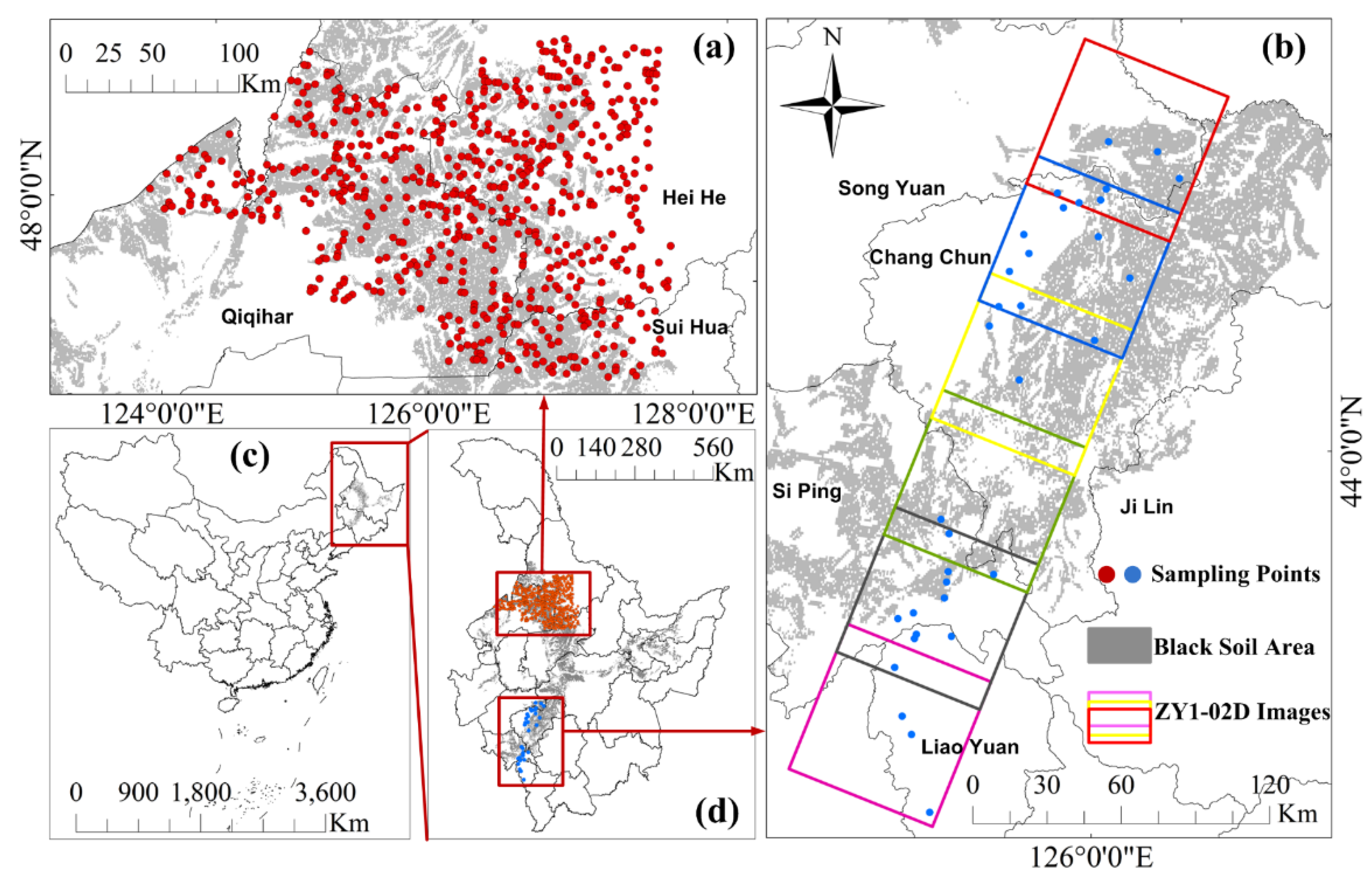
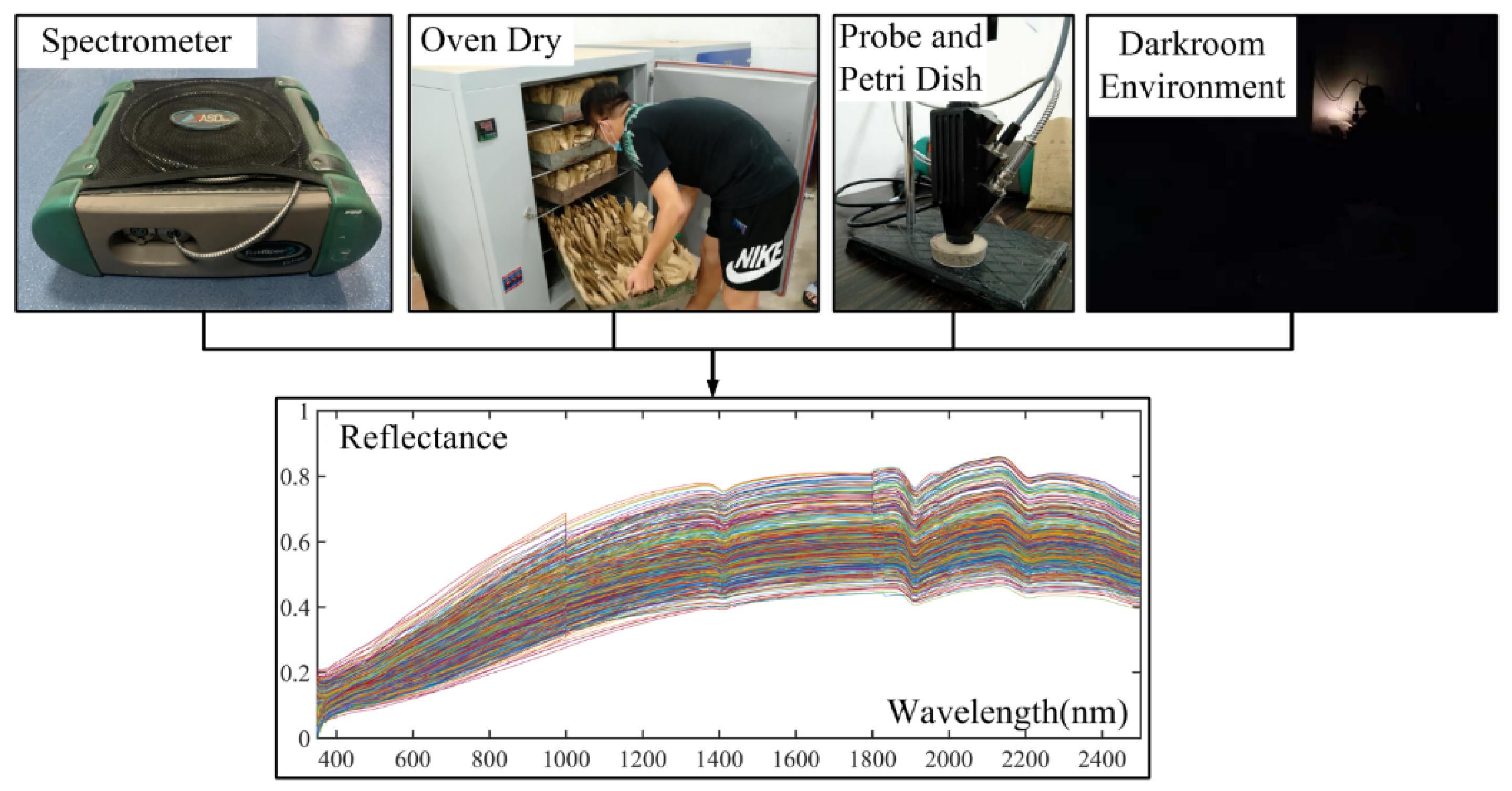

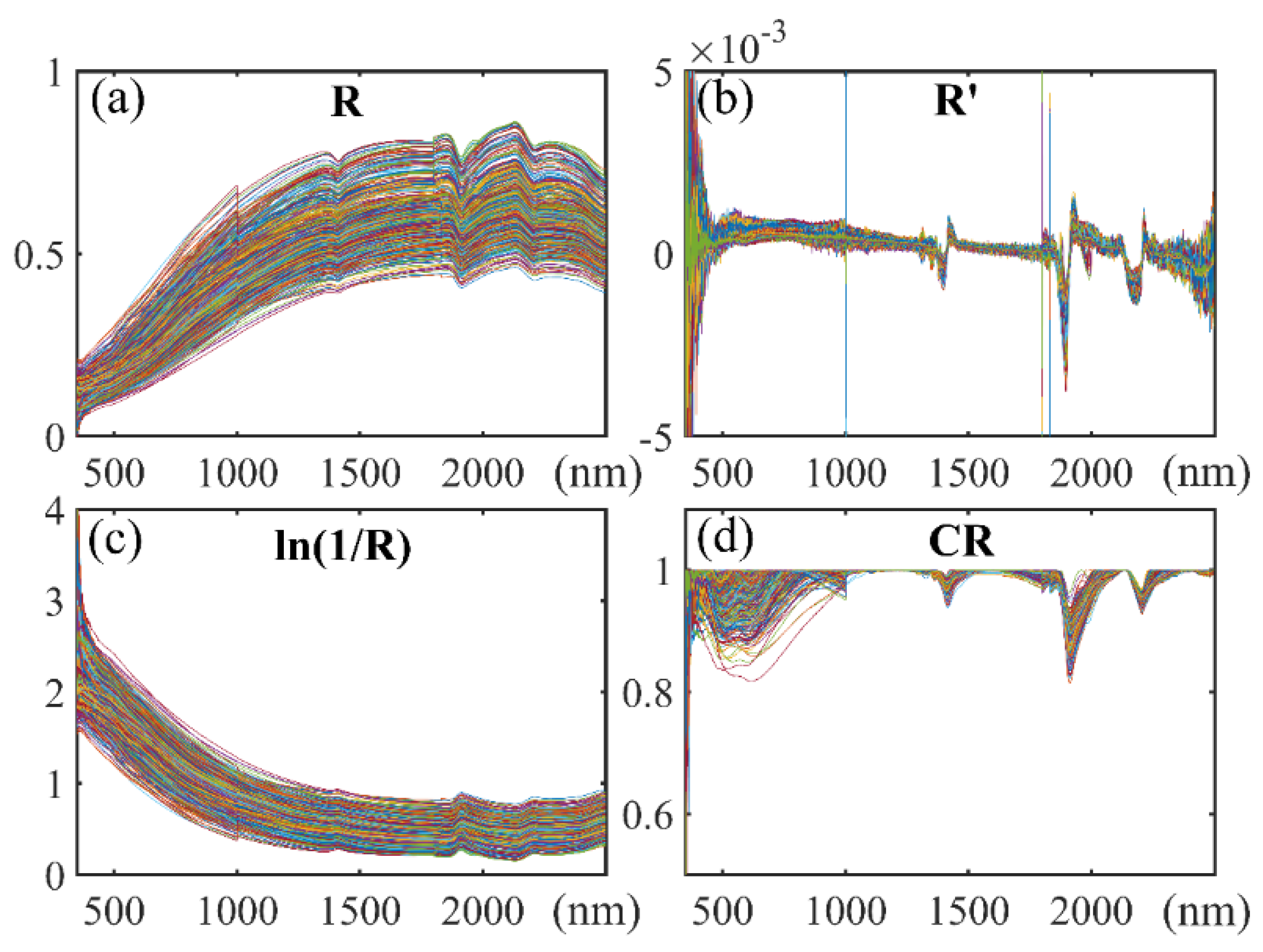

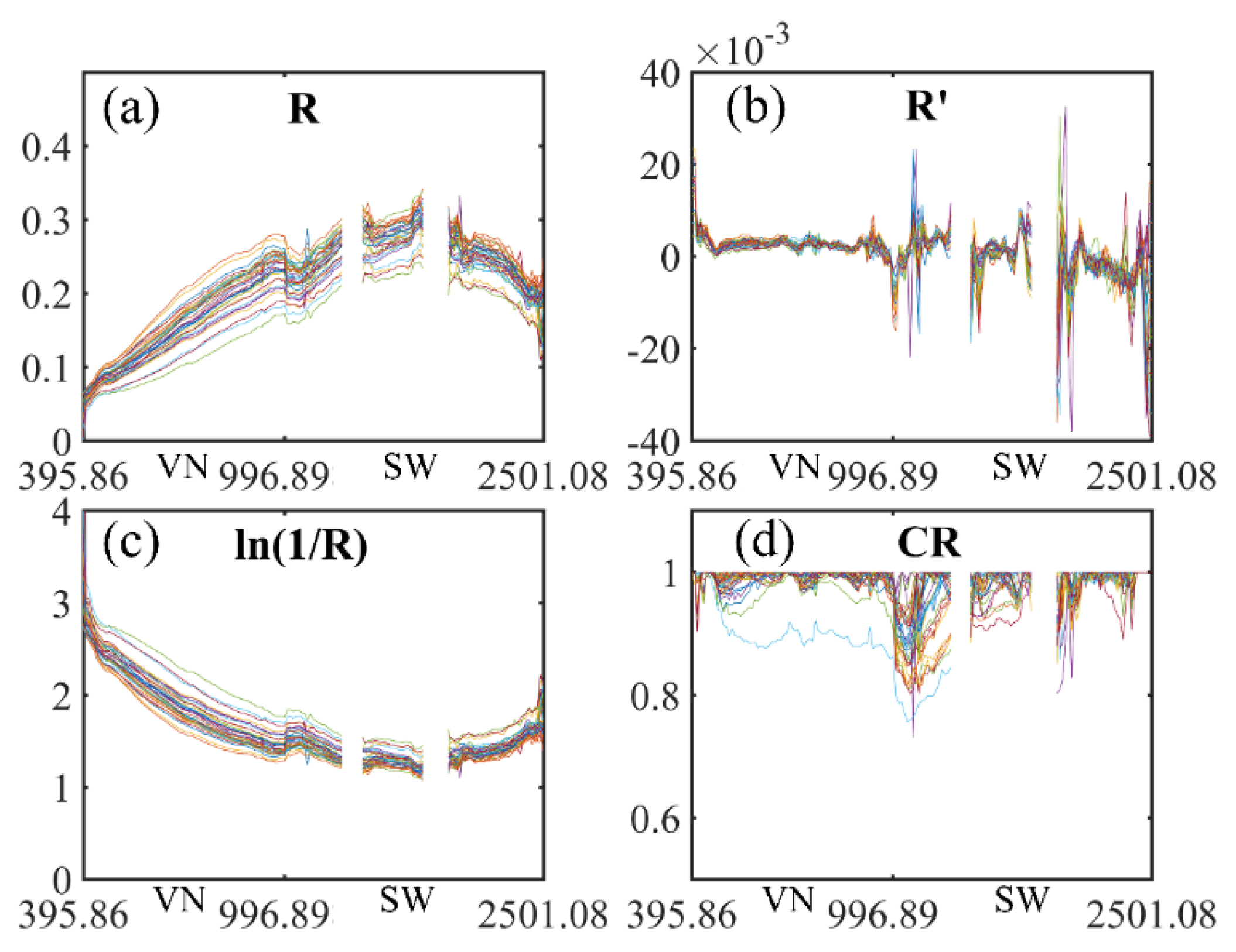

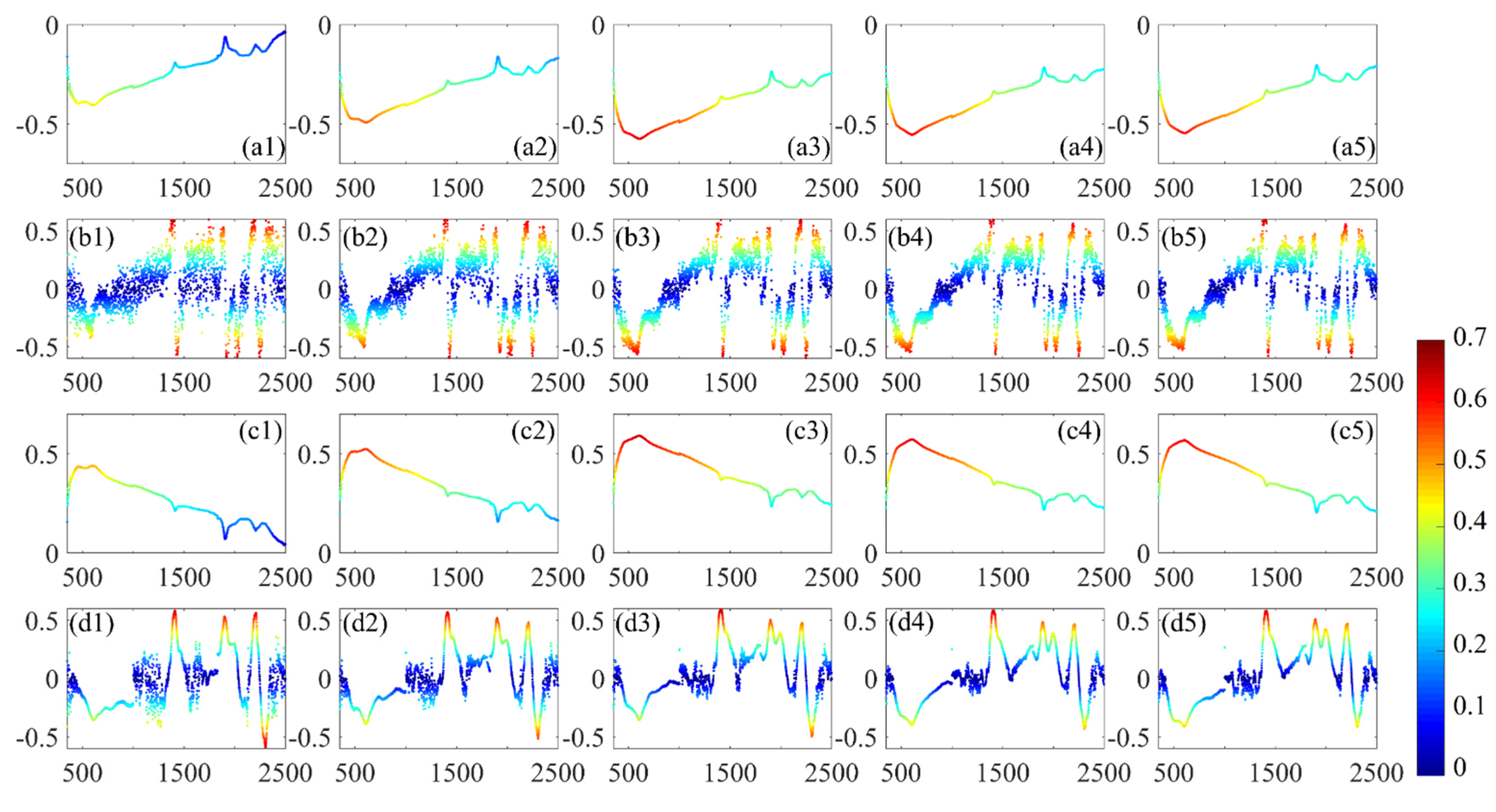
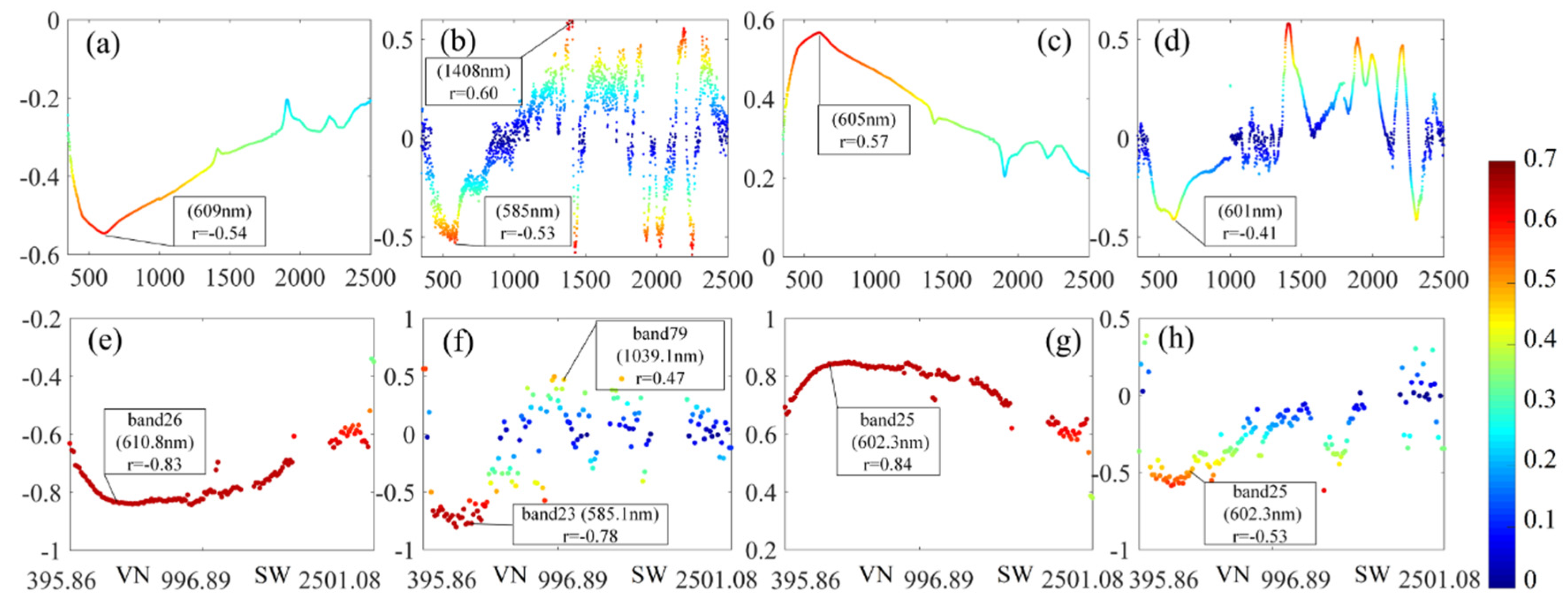

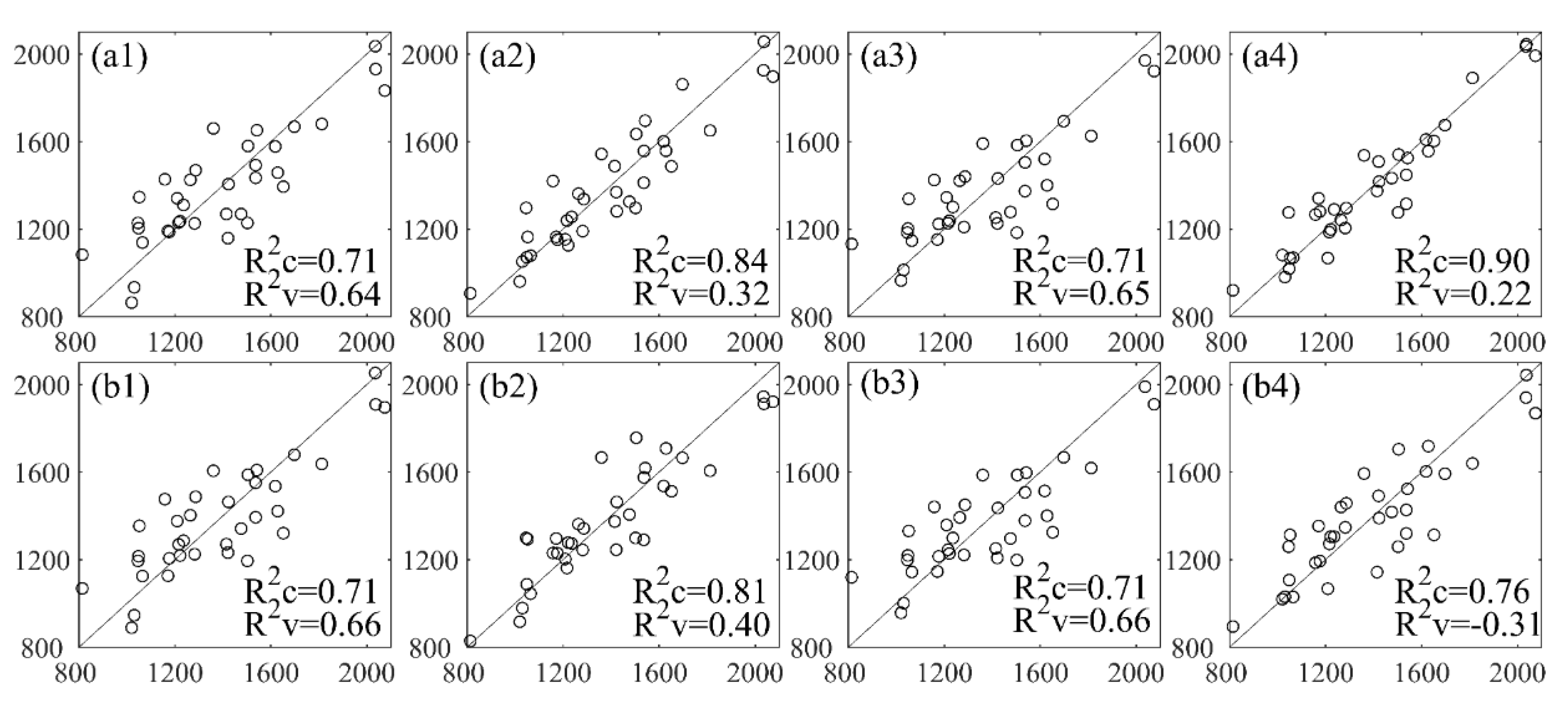
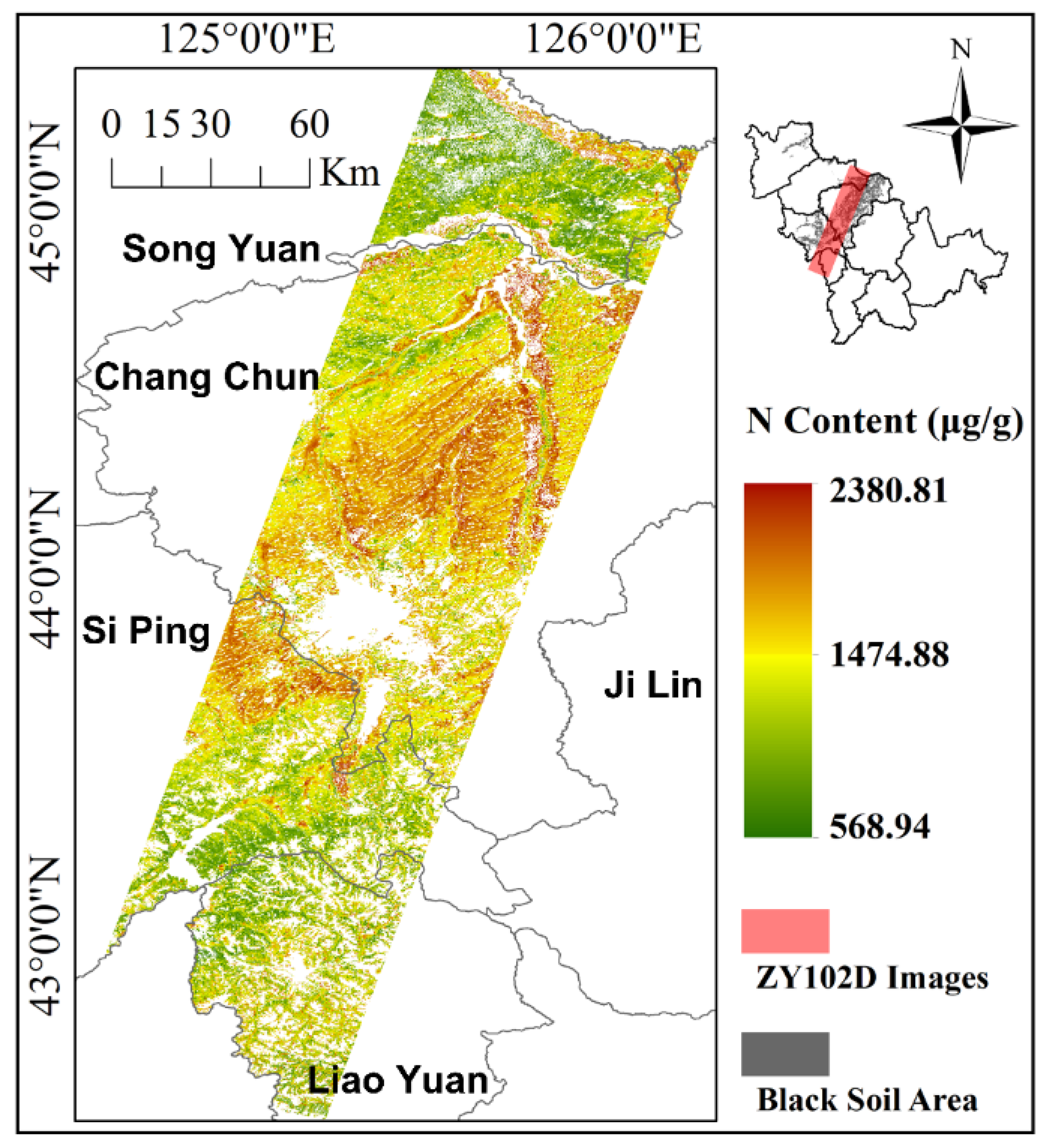
| Spectra | Range (Maximum Correlation Coefficient/Number of Bands) |
|---|---|
| R | 609 nm(385 nm–1260 nm)(−0.54/876) |
| R′ | 585 nm (−0.53/138); 1408 nm (0.60/51); 1429 nm (−0.58/20); 1598 nm (0.46/4); 1768 nm (0.45/10); 1890 nm (0.47/17); 1928 nm (−0.52/28); 2027 nm (−0.55/46); 2191 nm (0.56/44); 2249 nm (−0.59/35); 2321 nm (0.5143/19) |
| ln(1/R) | 605 nm (378 nm–1297 nm) (0.57/920) |
| CR | 601 nm (−0.41/24); 1406 nm (0.58/58); 1894 nm (0.51/45); 1996 nm (0.42/22); 2209 nm (0.47/30); 2305 nm (−0.41/10) |
| Spectral Form | LVs | Spectral Region | R2c | R2v | RMSEc | RMSEv |
|---|---|---|---|---|---|---|
| R | 2 | Full wavelength | 0.7112 | 0.6402 | 162.7501 | 181.6767 |
| R | 2 | Sensitive bands | 0.7081 | 0.6633 | 163.6195 | 175.7395 |
| R’ | 5 | Full wavelength | 0.8427 | 0.316 | 120.1107 | 250.4794 |
| R’ | 5 | Sensitive bands | 0.8091 | 0.3997 | 132.3331 | 234.6535 |
| ln(1/R) | 2 | Full wavelength | 0.7109 | 0.6561 | 162.8487 | 177.6151 |
| ln(1/R) | 2 | Sensitive bands | 0.7127 | 0.6583 | 162.3386 | 177.0468 |
| CR | 6 | full wavelength | 0.8981 | 0.2216 | 96.6815 | 267.2057 |
| CR | 6 | sensitive bands | 0.7600 | −0.3052 | 148.3587 | 346.0075 |
Publisher’s Note: MDPI stays neutral with regard to jurisdictional claims in published maps and institutional affiliations. |
© 2022 by the authors. Licensee MDPI, Basel, Switzerland. This article is an open access article distributed under the terms and conditions of the Creative Commons Attribution (CC BY) license (https://creativecommons.org/licenses/by/4.0/).
Share and Cite
Xu, Z.; Chen, S.; Zhu, B.; Chen, L.; Ye, Y.; Lu, P. Evaluating the Capability of Satellite Hyperspectral Imager, the ZY1–02D, for Topsoil Nitrogen Content Estimation and Mapping of Farmlands in Black Soil Area, China. Remote Sens. 2022, 14, 1008. https://doi.org/10.3390/rs14041008
Xu Z, Chen S, Zhu B, Chen L, Ye Y, Lu P. Evaluating the Capability of Satellite Hyperspectral Imager, the ZY1–02D, for Topsoil Nitrogen Content Estimation and Mapping of Farmlands in Black Soil Area, China. Remote Sensing. 2022; 14(4):1008. https://doi.org/10.3390/rs14041008
Chicago/Turabian StyleXu, Zhengyuan, Shengbo Chen, Bingxue Zhu, Liwen Chen, Yinghui Ye, and Peng Lu. 2022. "Evaluating the Capability of Satellite Hyperspectral Imager, the ZY1–02D, for Topsoil Nitrogen Content Estimation and Mapping of Farmlands in Black Soil Area, China" Remote Sensing 14, no. 4: 1008. https://doi.org/10.3390/rs14041008
APA StyleXu, Z., Chen, S., Zhu, B., Chen, L., Ye, Y., & Lu, P. (2022). Evaluating the Capability of Satellite Hyperspectral Imager, the ZY1–02D, for Topsoil Nitrogen Content Estimation and Mapping of Farmlands in Black Soil Area, China. Remote Sensing, 14(4), 1008. https://doi.org/10.3390/rs14041008






